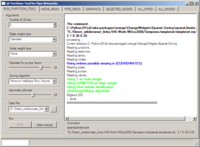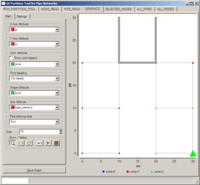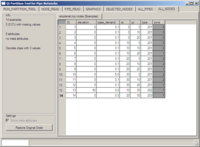Difference between revisions of "UNESCO-IHE Asset Management Tools"
| (12 intermediate revisions by the same user not shown) | |||
| Line 1: | Line 1: | ||
During the year 2008, a | During the year 2008, a set of modeling tools related to Asset Management of Networked Water Utilities were developed by students of Integrated Urban Engineering of [[UNESCO-IHE]] under our supervision. In order to make the use of these tools as painless as possible, we have adopted (with permission) the Orange data mining tool developed by the Artificial Intelligence Laboratory of Faculty of computer and information science, Ljubljana University to provide an integrated graphical user interface to the set of tools. We thank Janez Demsar, Blaz Zupan, Gregor Leban of Ai Lab for their cooperation in the interfacing phase. | ||
__TOC__ | |||
Currently there are three integrated tools in the system. | Currently there are three integrated tools in the system. | ||
| Line 7: | Line 9: | ||
==Download the software== | ==Download the software== | ||
[ | [[file:Orange-snapshot-2008-04-24-py2.5.zip]] | ||
== | ==Optimal zoning of water distribution networks== | ||
;Reference: J. Sempewo, A. Pathirana and K. Vairavamoorthy, Spatial analysis tool for development of leakage control zones from the analogy of distributed computing. [[media:sempewo_pathirana_vairavamoorthy_WDSA2008.pdf|PDF]] | ;Reference: J. Sempewo, A. Pathirana and K. Vairavamoorthy, Spatial analysis tool for development of leakage control zones from the analogy of distributed computing. [[media:sempewo_pathirana_vairavamoorthy_WDSA2008.pdf|PDF]] | ||
===How to use=== | ===How to use=== | ||
Install the software. There will be a start menu shorcut called <tt>Start->Programs->Orange->UNESCO-IHE</tt> with several shortcuts. The shortcut <tt>WNZoning</tt> directs to the zoning tool. The input file must be in EPANET 2.0 network format (<tt>.inp</tt> format). | Install the software. There will be a start menu shorcut called <tt>Start->Programs->Orange->UNESCO-IHE</tt> with several shortcuts. The shortcut <tt>WNZoning</tt> directs to the zoning tool. The input file must be in EPANET 2.0 network format (<tt>.inp</tt> format). | ||
==Tips on use== | ===Tips on use=== | ||
[[image:WNZoning_interface.png|thumb|200px|Input page of the zoning tool]] | [[image:WNZoning_interface.png|thumb|200px|Input page of the zoning tool]] | ||
[[image:WNZoning_interface1.png|thumb|200px|Zoning Results -- Graphics]] | [[image:WNZoning_interface1.png|thumb|200px|Zoning Results -- Graphics]] | ||
| Line 27: | Line 29: | ||
*; Asymmetry allowed: (Only for hmetis) The first priority of Hmetis is to provide contiguous zoning. However, this is always not possible to achieve while maintaining the required balance of zones (e.g. Demand in each zone or number of nodes in each zone.) This factor indicates by how much percentage this balance can be sacrificed. Always start with a small value. | *; Asymmetry allowed: (Only for hmetis) The first priority of Hmetis is to provide contiguous zoning. However, this is always not possible to achieve while maintaining the required balance of zones (e.g. Demand in each zone or number of nodes in each zone.) This factor indicates by how much percentage this balance can be sacrificed. Always start with a small value. | ||
*;Data file: EPANET 2.0 network (<tt>.inp</tt>) file for input. | *;Data file: EPANET 2.0 network (<tt>.inp</tt>) file for input. | ||
==Criticality analysis== | |||
* The software in completely included in the above distribution. Documentation to be written. | |||
==Water Safety Plans== | |||
* The software in completely included in the above distribution. Documentation to be written. | |||
==Copyright== | |||
* Orange software (C) Ai lab, Ljubljana University. | |||
* Algorithms for asset management and UNESCO-IHE Extensions in Orange software (C) UNESCO-IHE Institute for Water Education, Delft, The Netherlands. Dr. Assela Pathirana (Under the same conditions as original orange license) (E-mail. a.pathirana <at> unesco-ihe.org, Tel: +31(0)15 215 1854/Fax: +31(0)15 212 2921), 2008 | |||
* In publications please acknowledge by citing the reference(s) provided in the relevant section above. | |||
;Note: Content in this page may be restricted beyond the standard copyright of this site. | |||
==Some data== | |||
* data : [[media:criticality_example.zip|criticality_example.zip]] | |||
Latest revision as of 09:53, 14 May 2012
During the year 2008, a set of modeling tools related to Asset Management of Networked Water Utilities were developed by students of Integrated Urban Engineering of UNESCO-IHE under our supervision. In order to make the use of these tools as painless as possible, we have adopted (with permission) the Orange data mining tool developed by the Artificial Intelligence Laboratory of Faculty of computer and information science, Ljubljana University to provide an integrated graphical user interface to the set of tools. We thank Janez Demsar, Blaz Zupan, Gregor Leban of Ai Lab for their cooperation in the interfacing phase.
Currently there are three integrated tools in the system.
- A tool for optimal zoning of water distribution networks
- A criticality analysis tool for asset management of utility networks
- A visual programming tool for implementing water safety plans for water supply schemes.
Download the software
File:Orange-snapshot-2008-04-24-py2.5.zip
Optimal zoning of water distribution networks
- Reference
- J. Sempewo, A. Pathirana and K. Vairavamoorthy, Spatial analysis tool for development of leakage control zones from the analogy of distributed computing. PDF
How to use
Install the software. There will be a start menu shorcut called Start->Programs->Orange->UNESCO-IHE with several shortcuts. The shortcut WNZoning directs to the zoning tool. The input file must be in EPANET 2.0 network format (.inp format).
Tips on use
- When installing the software follow the default suggestions made by the installer.
- Following are a list of parameters to be specified:
- Number of Zones
- Edge weight type
- The parameter to be used to provide weights to the edges.
- Node weight type
- The parameter to be used to provide weights to the nodes.
- 'Diameter for pumps factor'
- Epanet does not specify a diameter value for a link representing a pump. Specify the diameter to be used for pumps, as a multiplier of the average pipe diameter of the network (for the purpose of weights above).
- Zoning algorithm
- In our experience Hmetis algorithms often provide better results. However, experiment.
- Asymmetry allowed
- (Only for hmetis) The first priority of Hmetis is to provide contiguous zoning. However, this is always not possible to achieve while maintaining the required balance of zones (e.g. Demand in each zone or number of nodes in each zone.) This factor indicates by how much percentage this balance can be sacrificed. Always start with a small value.
- Data file
- EPANET 2.0 network (.inp) file for input.
Criticality analysis
- The software in completely included in the above distribution. Documentation to be written.
Water Safety Plans
- The software in completely included in the above distribution. Documentation to be written.
Copyright
- Orange software (C) Ai lab, Ljubljana University.
- Algorithms for asset management and UNESCO-IHE Extensions in Orange software (C) UNESCO-IHE Institute for Water Education, Delft, The Netherlands. Dr. Assela Pathirana (Under the same conditions as original orange license) (E-mail. a.pathirana <at> unesco-ihe.org, Tel: +31(0)15 215 1854/Fax: +31(0)15 212 2921), 2008
- In publications please acknowledge by citing the reference(s) provided in the relevant section above.
- Note
- Content in this page may be restricted beyond the standard copyright of this site.
Some data
- data : criticality_example.zip


